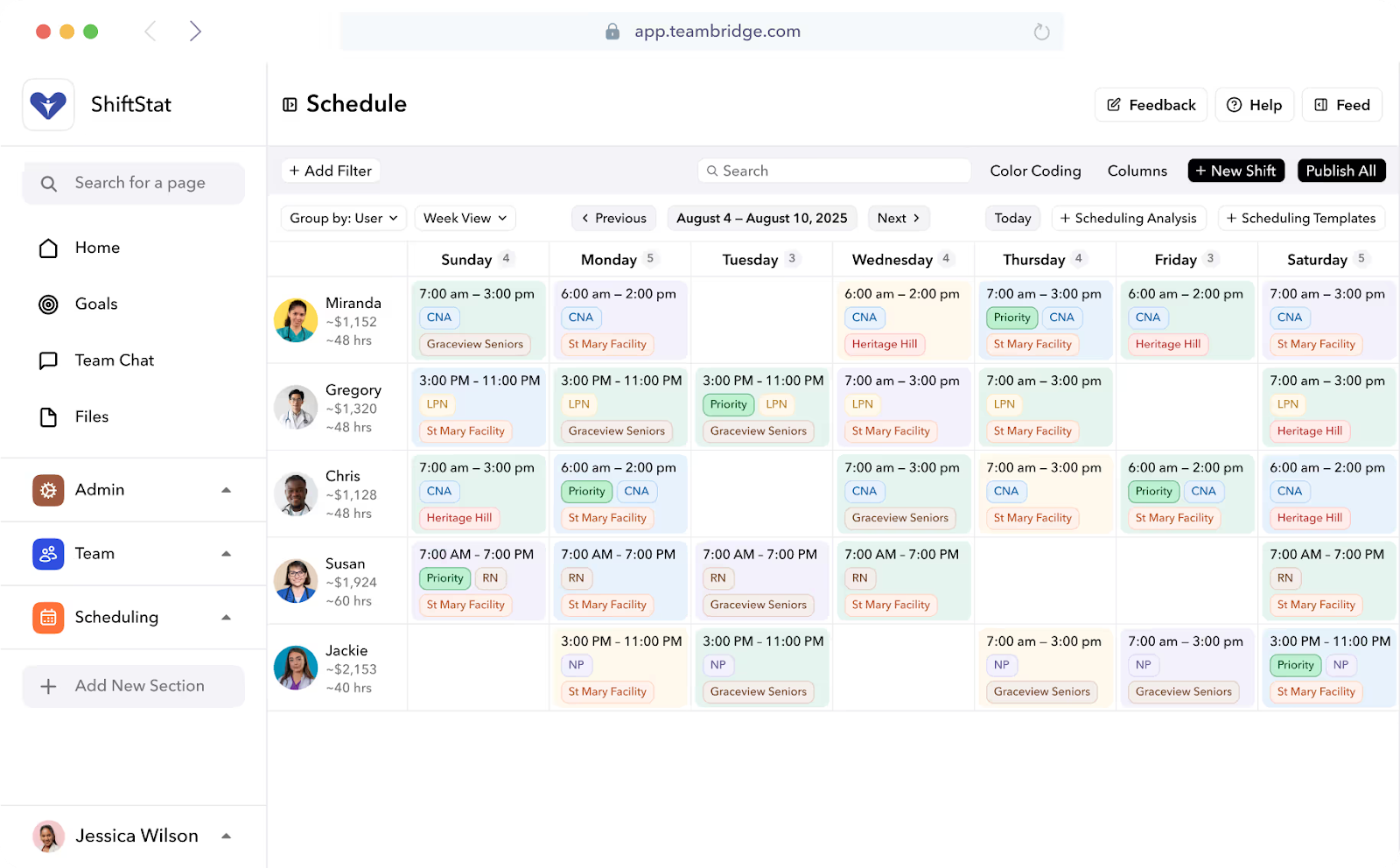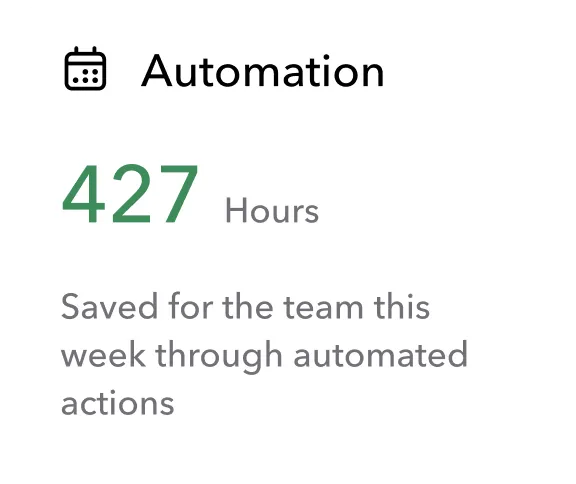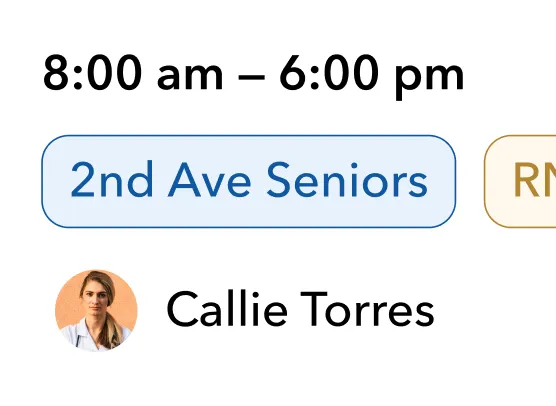Keeping a workplace staffed 24 hours a day is no small feat. Schedulers often struggle to cover every shift while also fighting fatigue, turnover, and rising scheduling conflicts. Recent Gallup research found that 41% of United States workers report little control over their schedules, which directly impacts retention and engagement.
To address these challenges, many staffing companies are looking beyond simple fixed shifts. One option gaining traction is the Panama schedule, also called the 2-2-3 scheduling pattern. This rotation balances 12-hour shifts with regular stretches of time off, creating a predictable cycle that can keep operations running around the clock without burning out staff.
This guide breaks down exactly how the Panama schedule works, explores its benefits and challenges, and shares best practices for putting it into action. We’ll also look at how tools like Teambridge can make managing complex rotations easier, from automating rules to coordinating shift-based communication.
What is a Panama schedule?
A Panama schedule is a type of rotating shift pattern designed to provide seamless 24/7 coverage while giving employees consistent blocks of rest. Instead of a simple “five days on, two days off” structure, it uses a repeating two-week or four-week cycle that alternates workdays and rest days in longer stretches. The result is a system that balances operational needs with predictable downtime, which can help reduce fatigue and turnover.

Instead of traditional fixed shifts, the Panama model staggers teams across 12-hour shifts to ensure there are always staff on duty without overloading any one group. Its defining feature is the 2-2-3 work schedule: two days on, two days off, three days on, then the opposite during the following week. Because the cycle repeats, staffing agencies can plan months in advance while employees enjoy knowing exactly when their time off will fall.
For example, in a hospital setting, a nursing schedule might split the team into two groups. Group A works Monday and Tuesday, rests Wednesday and Thursday, and then works Friday through Sunday. Group B works the opposite shifts. The following week, the pattern flips. This guarantees continuous coverage on the floor, while also ensuring nurses have extended recovery periods to manage the physical and emotional demands of their work.
Organizations that embrace mobile workforce management platforms can take the Panama schedule one step further. Rather than juggling spreadsheets or making last-minute calls, schedulers can automate rotation rules, track availability in real time, and coordinate shift changes directly through a mobile app. This simplifies operations and gives staff more control, particularly in industries like healthcare, manufacturing, and public safety, where 24-hour reliability is critical.
Top tips for implementing a Panama schedule
Implementing a Panama schedule takes more than just understanding the 2-2-3 pattern. With the right tools and strategies, you can turn a complex rotation into a smooth, predictable system that supports both staff well-being and operational continuity.
1. Encode your 2-2-3 rule set
Start by embedding the core logic of the Panama schedule directly into your scheduling system. Define the two‑week 2‑2‑3 rotation formally so that every cycle, from two days on to two days off to three days on, is consistently applied. Organizations using structured shift patterns report up to a 15% improvement in schedule adherence and a decrease in midweek burnout—indicators that formal rules yield real results.
With Teambridge, you can set granular rules that define who works when, so your 2-2-3 schedule auto-builds accurately every cycle. That means you spend less time tweaking shifts and more time focusing on operations.
2. Save and reuse a Panama schedule template
Once your rule set is in place, the next step is to save it as a reusable template within your workforce planning tool. This makes building new cycles as simple as loading the template and updating staff assignments, rather than starting from scratch each time.
Teams with repeatable patterns save hours per scheduling cycle and dramatically cut down on errors. With Teambridge’s drag-and-drop builder, you can duplicate a Panama schedule template in seconds, then fine-tune staffing as needed. This level of efficiency keeps operations consistent and staffing agencies focused on higher-value priorities instead of manual admin tasks.
3. Sync employee availability
Maintaining a balanced Panama schedule hinges on knowing who is actually available. Fatigue, last-minute PTO, or unexpected absenteeism can quickly throw off coverage, making real-time visibility essential.
Research shows that adopting mobile contingent workforce management solutions can increase productivity by 30% on average. With Teambridge’s employee scheduling app, staff can update their availability from anywhere, and you see those changes instantly. The result is fewer last-minute scrambles, lower stress levels for both managers and employees, and schedules that respect the need for regular breaks.
4. Automate compliance checks
The Panama schedule relies on long shifts and night work, which make compliance more than just a box to check. Without proper safeguards, schedulers risk not only legal violations but also fatigue-related errors and impacts to employee mental health. Since manually auditing every schedule for overtime, break rules, and rest periods is nearly impossible at scale, automating compliance is critical.
Teambridge's workforce compliance features enforce rules for overtime, daily limits, and required regular breaks directly in the schedule. Instead of worrying about errors or liability, you can be confident every cycle is both fair and safe.
By letting the system handle compliance, you cover your bases and protect what matters most: your people and your organization.
5. Enable self-service shift swaps
Even the most carefully built Panama schedule needs room for flexibility. Allowing employees to handle their own shift swaps through an employee mobile app gives them greater control over their work-life balance. When staff can request swaps, claim openings, and confirm approvals directly in the system, it helps them better manage family commitments, rest days, and personal plans.
Modern scheduling software like Teambridge streamlines this process by keeping swaps transparent and organized, which supports both continuous operations and happier teams. That level of autonomy not only boosts job satisfaction but also reduces last-minute chaos.
Common challenges associated with Panama schedules
While the Panama schedule can bring structure and predictability to 24/7 staffing, it isn’t without hurdles. Staffing agencies often face a few recurring challenges that can impact both operations and employee morale.
1. Coverage gaps and handoff errors
Because Panama rotations rely on long 12-hour shifts and frequent handoffs, it’s easy for details to slip through the cracks. A missed update or misaligned start time can leave critical roles uncovered.
AI-driven scheduling makes a difference by analyzing patterns across teams so you can address potential gaps before they occur, optimize handoffs, and even recommend adjustments that minimize the risk of mischeduling. Teambridge’s AI tools for frontline workforce management help you maintain comprehensive coverage without constantly double-checking every transition.
2. Employee fatigue and work-life balance challenges
Extended shifts, night work, and rotating patterns can make it tough for employees to stay rested and maintain a healthy work-life balance. Fatigue not only impacts performance but also affects morale and retention.
You can help your teams by building in extra recovery days, monitoring overtime, and creating policies that prioritize mental health. Ensuring staff have predictable breaks and open communication channels goes a long way toward making the Panama schedule sustainable.
3. Fairness and schedule equity
Another challenge is ensuring fairness across the team and distributing less desirable shifts evenly. Employees often compare workloads, night shifts, and weekend assignments, and perceived inequities can damage trust.
Using consistent rules and transparent scheduling software helps you demonstrate that you distribute rotations evenly. With clear communication—and the data to back it up—you can reinforce a sense of equity that keeps your teams engaged.
4. Last-minute changes and exceptions
Even the most well-planned schedule is vulnerable to callouts, emergencies, or unexpected absences. Handling these manually often leads to stress and confusion, which is why many organizations turn to mobile workforce management platforms.
With tools like Teambridge, you can push updates in real time, while employees manage swaps or pick up shifts directly from their phones. This approach streamlines communication and protects continuous operations when plans change unexpectedly.
Streamline and automate Panama scheduling with Teambridge
The Panama schedule offers a practical way to maintain 24/7 coverage while giving employees predictable time off. However, it also comes with the challenges of managing long shifts, mitigating fatigue, handling last-minute changes, and ensuring fairness across the team.
By following best practices like encoding rule sets, saving templates, syncing availability, and automating compliance, you can keep this rotation running smoothly.
That process becomes far easier with the right tools. Teambridge’s scheduling solution centralizes shift management, automates 2-2-3 rotation rules, supports real-time updates, and empowers staff through mobile access. The result is reduced admin time, stronger engagement, and reliable coverage around the clock.
Ensure 24/7 coverage and streamline Panama scheduling. Request a demo of Teambridge today.
FAQs about Panama schedules
What is a 2-2-3 schedule?
A 2-2-3 schedule is a rotating schedule often used in 24/7 operations. Employees work 12-hour shifts in a repeating cycle: two days on, two days off, three days on, followed by the reverse the next week. This pattern balances continuous coverage with predictable time off.
What’s an example of a Panama schedule?
Here’s a Panama schedule example:
- Week 1: Work Mon–Tue, off Wed–Thu, work Fri–Sun
- Week 2: Off Mon–Tue, work Wed–Thu, off Fri–Sun
This Panama shift pattern then repeats, ensuring full 24/7 coverage with consistent recovery days.
What are the top benefits of Panama schedules?
The Panama schedule offers several advantages:
- Built-in three-day weekend every other week
- More predictable time off compared to irregular rotations
- Balanced workweek distribution across teams
- Better coverage for round-the-clock operations








.png)
.png)
.png)